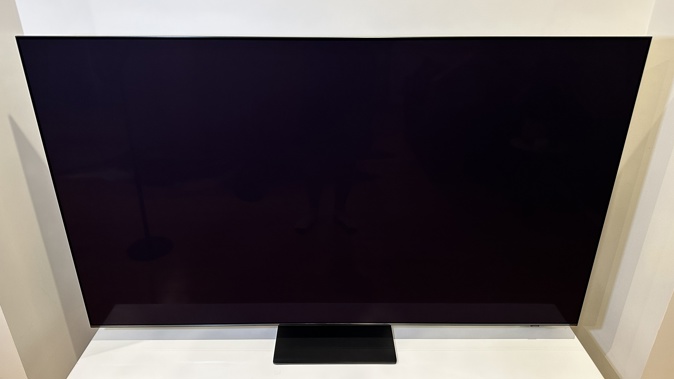
I have tried to understand it. Believe me I've tried. I've Googled it extensively. I've read dozens of articles. I've talked to experts. I swear I've done my darnedest to get my head around it.
And yet...
I'm still not a hundred percent sure I really know the diffference between an OLED TV and a QLED one.
I know it's got something to do with whether the pixels light themseleves up or they're illuminated from a separate panel behind. And now that I write that down I'm pretty sure even that isn't really correct.
My point is; who cares?
Like any bit of tech, it doesn't really matter how it works, as long as it works, right?
All I really know for certain, even after all this time, is QLED TVs (and more latterly, Neo QLEDs) are reputed to be brighter, while OLED tellies are supposed to be blacker.
Generally speaking. In layman's terms.
Which begs the question; what would happen if you could kind of combine the two?...
In 2017 Samsung hitched its wagon to the QLED horse and ran with it. In my humble opinion, they've pretty much owned the "Best TV in the World" title every year since. Every year I wonder how they'll be able to improve on such colour, depth and detail and yet every year, when I get to see their flagship TV for myself, I'm amazed all over again.
Recently, Samsung's Qantum Mini LED technology heralded the evolution to Neo QLED and yes, that meant an even more remarkable picture still. It also meant Samsung gained serious ground in the "not completely black" debate - even converting some OLED stalwarts in the process.
This year, the new Neo QLED options don't disappoint - especially the top-the-line 8K QN900C which produces the closest thing I've ever seen to a 3D image on a standalone TV screen.
But Samsung is now diving into the OLED pool too and for the last couple of weeks I've been taking a good look at the 4K S95C.
This brave new journey for Samsung begins before you even take it out of the box - like most Samsung products the commitment to protecting the environment is evident with hardly any ink being used on the packaging and no adhesive tape. Unfortunately, there's still about half a tonne of polystyrene keeping the TV safe and secure inside the box but hopefully Samsung will phase that out soon, just as they have dispatched single-use batteries from the remote controls.
Yes, the solar-charged remote is just one of many innovations Samsung has tranferred across from its Neo QLED line - in fact, they've made the technology open-source so any manufacturer can now offer a remote that charges itself.
Another feature I've come to love about Samsung TVs is the One Connect box. If you're not familiar, this is all the guts of the TV - the processing hardware, the I/O ports, the power input etc. - in a separate box which is then connected to the screen by a single cable.
This means you have unlimited versatility when it comes to positioning the TV - it can hang flush against the wall if you don't want to use the included stand (which is very easy to assemble, looks subtle and provides reliable, stable support). And when I say flush to the wall, in the case of the S95C, the panel is just 11mm thick. That's even slimmer than the Samsung Neo QLEDs. It's a stunning thing - to see a huge TV like this basically just stand as a piece of glass and nothing else.
If you choose to, you can elect to attach the One Connect box to the stand itself. This means you don't need a cabinet or cupboard to hide anything away - there's even an optional cover to conceal the cables leading to any other external devices.
The S95C - like any Samsung TV - runs the Tizen OS, Samsung's own smart TV interface which has been streamlined over the years and offers all the apps I'm looking for, from popular streaming services to more customiseable tools like Plex, which allows me to view content from my own server over my home Wi-Fi network.
Speaking of apps, excitingly there is now a Tizen version of Philips Hue. This means you can now sync your onscreen content with any Hue Play lights you own without having to use the HDMI Sync Box. The Hue app is expensive; over NZ$200.00 but the Sync Box is really expensive - NZ$549.95 - so if you like the idea of using Hue lighting with your Samsung TV, it's actually a big saving.
As is the Xbox app. I first used this last year and it's working better than ever on the S95C. All you need is an Xbox Game Pass Ultimate subscrption and you can choose from the hundreds of games available on the Xbox Cloud Gaming platform - no console required. The S95C's excellent refresh rate, detailed picture and dazzling brightness all add up to a fantastic gaming experience.
But before we discuss picture quality, just one more OS feature - Samsung TV Plus; dozens of subscription-free live channels for your entertainment. Sport, movies, comedy, kids, reality TV - there's actually a surprising amount of stuff just waiting to be watched.
Setting all this up is easy - easier still using the Smart Things app on your phone. Even easier still if you're upgrading from a previous Samsung TV as many of your settings can backed up and transferred.
Alright, finally - let's discuss the viewing experience. As mentioned earlier, I had some reservations about how well an OLED screen would perform in my very exposed, window-filled living room - especially given I watch a lot of TV in the middle of the day due to my weird work hours.
I didn't have to worry.
Samsung describes the technology as Quantum HDR OLED+. Apparently, the result is so good it's been Pantone Validated. Yes, they're the paint people and they know their colours. This true-to-life reproduction is especially notable when it comes to skin-tone. In the past I've spent hours tweaking various settings trying to get people to look like actual people - but not with the S95C. I simply ran the automatic calibration test when prompted during setup and never had to change a thing.
This telly is a great watch. The only thing I'd change if I could is the width of the bezels around the edge. They're not large by most standards but they are black and compared to the QLED panel I'm used to watching I did feel a little boxed-in from time to time.
Yet another feature borrowed from Samsung's recent QLED flagships is the excellent object-tracking sound array - this is where the Neural Quantum Processor devotes some of its impressive brainpower to following the sound of the action across the screen - or even above it using top channel speakers for the full Dolby Atmos experience. As built-in TV speakers go they're good. Very good.
But you know what's better? A nice soundbar paired with a wireless subwoofer.
Enter the HW-S801B.
What do you mean you can't see it? It's right there. That skinny little black thing. (Also available in white)
Obviously I was skeptical about how good something so tiny would sound - would there be any advantage over just sticking with the Q95C's built-in array? As it turns out, yes indeedy do.
The S801B is like a magic trick, matching many larger, full-sized options I've tried, blow for blow. It's so small it has to connect by a special micro-HDMI cable - not to worry, that's included in the box. Somehow there are still ten speakers packed in there and you you still get Dolby Atmos effects. And yes, just like recent QLED TVs, the Q95C will pair with the S801B to provide Samsung's ingenious Q-Symphony effect - combining the TV's built-in speakers, the soundbar and its subwoofer altogether for maximum effect. As with the visual calibration tool, this hybrid soundsystem will also automatically adapt to your room to provide the best aural experience possible.
I still missed my rear speakers for a true surround effect (Samsung offers separate wireless rear speaker kits) but I was surprised and then satisfied by how well this sound setup worked. And the Domestic Manager loved the way it looked - ie; she couldn't see it at all because I'd tucked the tiny soundbar underneath the TV.
I could go on all day and into the night about what a complete entertainment package the Q95C (and soundbar) truly is. Just know that any reservations I had about brightness (or the soundbar not being beefy enough) were totally unfounded and I was relieved to discover all the flagship Samsung features I've come to depend on over the years were built into its OLED version too.
For my personal preference, the picture on the new 8K Neo QLED panel is still superior but if you're a dyed in the wool OLED fan, boy oh boy has Samsung come up with the goods for you.
Click here for more information on the Samsung OLED 4K S95C.
Click here for more information on the Samsung HW-S801B soundbar.
Take your Radio, Podcasts and Music with you
















